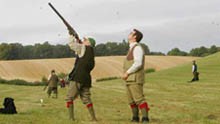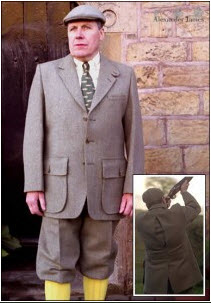
Recently I was invited pheasant hunting by Bill, a former South West chairman of the National Farmers Union. Bill is a six foot four gangly baritone, a sort of West Country Ian McKellen, and when he invites you pheasant hunting you say yes. I said yes.
Bill picked me up on Monday morning of what turned out to be the last day of hunting season. As I had never been shooting before it was agreed that I would be a ‘beater’ for the day. ‘To be a really effective beater,’ I was told, ‘you have to think like a pheasant.’ This didn’t, I assume, mean emptying my mind into a kind of Zen like pheasant stupidity. Bill assured me that the gamekeeper would give me very clear instructions and there was absolutely no chance at all of me being shot. So that was encouraging.
When we arrived at ‘the hunt’ I very quickly realised two things. I was about thirty years younger than anyone else, and I was extremely underdressed. The standard kit consisted of khaki wellingtons, long green socks tied up with red tassels worn outside of the boots, tweed plus fours, a tweed hunting jacket, a tweed vest, tweed tie and a tweed flat cap. There was a lot of tweed.

This ensemble was accessorised by a leather shot case, an empty shotgun case across slung across the shoulder and a loaded shotgun resting jauntily in the crook of the arm. It was as if they were going to a dress up party. And in a sense I suppose they were.
When the hunt was assembled there were about ten ‘guns’ and six or seven beaters – which I was told was a fairly modest turnout due to the lateness in the season. At 9am sharp, we all gathered in a well appointed shed, were given a brief outline of what the day was to entail (shooting pheasants apparently) and then proceeded to the serious business of standing around and drinking port.
I don’t normally drink that early in the morning, but then again I don’t normally help a bunch of old men shoot birds, so I figured today could be an exception. After half an hour or so of port drinking we went out for an hour of shooting, and then came back for ‘elevenses’. It’s a pretty good system really.
So dosed up on port and heavily armed, we all jumped in the back of a couple of utes swarming with dogs and drove off to the first drive. (You learn all sorts of new lingo doing something like this. A ‘drive’ is both the area of cover crop where the unsuspecting pheasants are hiding and the act of driving the pheasants up into the air.) The guns positioned themselves strung out in a line along the bottom of one field, whilst my fellow beaters and I made our way into a higher field of cover crop, separated from the guns by a hedgerow (‘cover crop’, often kale, is grown specifically for the pheasants to hide under).
The rest of the beaters were up the top of the filed in a line and when the gamekeeper blew a horn they walked down towards the guns flushing out the birds. The dogs did most of the work, running around like mad beneath the kale chasing out anything they could find. Meanwhile I was stationed at the bottom of the cover crop field, next to the hedge, in between the guns and the pheasants.
Now, I know I’m pretty new at this, but standing in between the guns and the things the guns are shooting at didn’t strike me as such a great idea. Luckily I was armed with a flag. My role, as it turned out, was to wave my flag at any low flying pheasants so they would stay up longer and be easier and safer to shoot. Safer for who I’m not sure, but in any case no one got shot – myself included – so I guess I did an OK job.
In an effort to try and recapture some of the excitement of the whole thing, I found this rather poorly produced clip, which I feel has a sort of Hertzogesqe absurdist genius to it.
OK, that might be getting a bit carried away, but the point is, not a great deal happens. And then you have lunch.
The pheasants are farmed for sport. A syndicate of shooters – often men of some local importance, always men – will buy the pheasants as chicks and pay for them to be kept on a piece of farmland. The chicks are well looked after, fed and kept in large free-range pens until they are big enough to be shot. Then they are let go. The really interesting thing is that at the end of the season only an average of a third of the birds have been killed.
The rest of them just wander off. This is why there is a large pheasant population in rural England, even though the bird is a native of Russia. When you think about it, letting two thirds of the birds go is actually much more humane than most farming practices. At least it is if you ignore the shooting them with buckshot part.
I thought pheasant shooting was a typical rural English antiquated past time, like Morris Dancing, or saying thank you to the bus driver. But as it turns out, like Dogging and Tescos home delivery, despite being around for a long time the current popularity of pheasant shooting is actually quite a recent phenomenon.Clubs and syndicates are apparently setting up at a record rate. I can see why.
I’m not much interested in shooting – actually I think it’s stupid and cruel – but dressing up and drinking port in the English countryside is lovely, and not entirely spoilt by the occasional gunshot. Now I just have to get one of those suits.







Crikey is committed to hosting lively discussions. Help us keep the conversation useful, interesting and welcoming. We aim to publish comments quickly in the interest of promoting robust conversation, but we’re a small team and we deploy filters to protect against legal risk. Occasionally your comment may be held up while we review, but we’re working as fast as we can to keep the conversation rolling.
The Crikey comment section is members-only content. Please subscribe to leave a comment.
The Crikey comment section is members-only content. Please login to leave a comment.